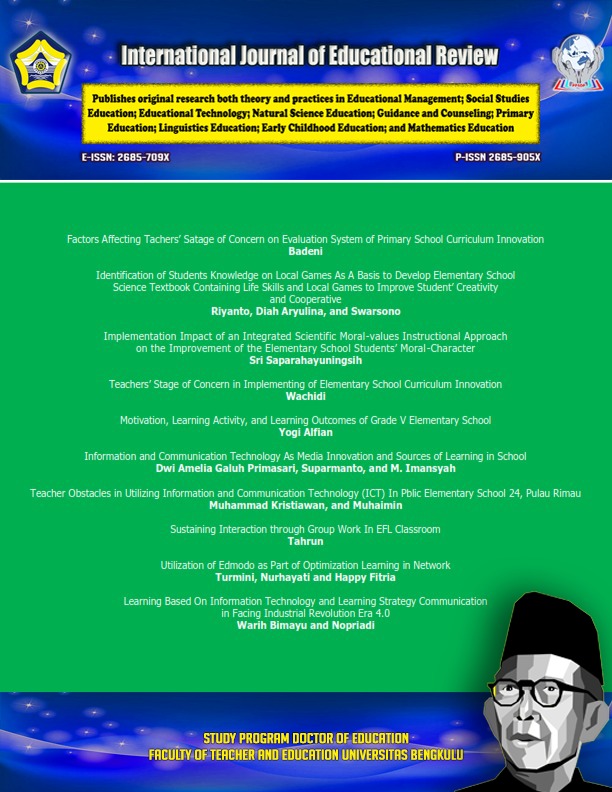An Analysis of Students’ Perceptions on Google Classroom Media Used By English Teachers during Pandemic Covid-19
DOI:
https://doi.org/10.33369/ijer.v4i2.22822Keywords:
Perceptions, Online Learning, Google ClassroomAbstract
Online learning or virtual classrooms use technology to help students and teachers with distance learning, with teachers providing accessible teaching materials. The purpose of this study is to describe students' perceived convenience and usefulness of Google Classroom material. This was a quantitative research that used a Likert Scale questionnaire. This study focuses on XI IPS students at SMAN 8 Bengkulu. To estimate the proportion of students' scores, data was analyzed using Sudjana's provided algorithm. The results suggest that around 79 percent, or more than half of the students, find it easy to study by utilizing Google Classroom since it offers an easy operating system and features that are simple to comprehend. Overall, based on the result of the research, there was more than half of the total demonstrated positive perceptions.
References
Al-Maroof, R. A. S., & Al-Emran, M. (2018). Students acceptance of google classroom: An exploratory study using PLS-SEM approach. International Journal of Emerging Technologies in Learning, 13(6). https://doi.org/10.3991/ijet.v13i06.8275
Arora, A. K., & Srinivasan, R. (2020). Impact of pandemic covid-19 on the teaching – learning process: A study of higher education teachers. Prabandhan: Indian Journal of Management, 13(4). https://doi.org/10.17010/pijom/2020/v13i4/151825
Astuti, T., & Indriani, L. (2020). THE EFL STUDENTS’ PERCEPTIONS IN USING GOOGLE CLASSROOM FOR ENGLISH LEARNING DURING PANDEMIC. Jurnal Review Pendidikan Dan Pengajaran, 3(2). https://doi.org/10.31004/jrpp.v3i2.1333
Bartley, S. J., & Golek, J. H. (2004). Evaluating the cost effectiveness of online and face-to-face instruction. In Educational Technology and Society (Vol. 7, Issue 4).
Bower, M., Dalgarno, B., Kennedy, G. E., Lee, M. J. W., & Kenney, J. (2015). Design and implementation factors in blended synchronous learning environments: Outcomes from a cross-case analysis. Computers and Education, 86. https://doi.org/10.1016/j.compedu.2015.03.006
Cresswell, J. W., Plano-Clark, V. L., Gutmann, M. L., & Hanson, W. E. (2003). Advanced mixed methods research designs. Handbook of Mixed Methods in Social and Behavioral Research.
Darmawati, Bundu, P., & Manda, D. (2017). Problem Based Learning Model Development of Civic Education to Improve the Motivation and Learning Outcomes. INTERNATIONAL JOURNAL OF ENVIRONMENTAL & SCIENCE EDUCATION, 12(9).
Dwi Febriani, R. (2018). Persepsi Peserta Didik Sekolah Menengah Atas Terhadap Pendidikan Lanjutan. Jurnal Pendidikan Dan Pembelajaran, 3(1).
Engelhart, M. D. (1975). Book Reviews : John A. R. Wilson, Mildred C. Robeck, and William B. Michael. Psychological Foundations of Learning and Teaching. (2nd ed.) New York: McGraw-Hill, 1974. Pp. xv & 589. $10.95 and $8.95 (paperback. Educational and Psychological Measurement, 35(1). https://doi.org/10.1177/001316447503500141
Evans, J. R., & Haase, I. M. (2001). Online business education in the twenty-first century: An analysis of potential target markets. Internet Research, 11(3). https://doi.org/10.1108/10662240110396432
Hamid, S. M. (2020). ONLINE DIGITAL PLATFORMS DURING COVID-19 IN EFL CLASSES: VISUAL IMPAIRMENT STUDENT’ PERCEPTION. ETERNAL (English, Teaching, Learning, and Research Journal), 6(2). https://doi.org/10.24252/eternal.v62.2020.a10
Hoi, S. C. H., Sahoo, D., Lu, J., & Zhao, P. (2021). Online learning: A comprehensive survey. Neurocomputing, 459. https://doi.org/10.1016/j.neucom.2021.04.112
Khalil, Z. M. (2018). EFL Students’ Perceptions towards Using Google Docs and Google Classroom as Online Collaborative Tools in Learning Grammar. Applied Linguistics Research Journal. https://doi.org/10.14744/alrj.2018.47955
Majmu Fatawa wa Rasail Fadhilah al-Syaikh Muhammad. (n.d.).
Mannong, A. B. M. (2020). THE STUDENTS’ EYESIGHT: THE EFFECTIVENESS OF LEARNING-BASED APPLICATIONS ON ELT IN PANDEMIC ERA. ETERNAL (English, Teaching, Learning, and Research Journal), 6(2). https://doi.org/10.24252/eternal.v62.2020.a14
Miarso, Y. (2007). Menyemai Benih Teknologi Pendidikan. In Computer.
Mohammadi, M. (2010). Febrile seizures: Four steps algorithmic clinical approach. In Iranian Journal of Pediatrics (Vol. 20, Issue 1).
Normadewi, B. (2012). Analisis Pengaruh Jenis Kelamin Dan Tingkat Pendidikan Terhadap Persepsi Etis Mahasiswa Akuntansi Dengan Love of Money Sebagai Variabel Intervening. Universitas Diponogoro.
Oktaria, A. A., & Rahmayadevi, L. (2021). STUDENTS’ PERCEPTIONS OF USING GOOGLE CLASSROOM DURING THE COVID-19 PANDEMICC. International Journal of Educational Management and Innovation, 2(2). https://doi.org/10.12928/ijemi.v2i2.3439
OSHA. (2020). Guidance on Preparing Workplaces for COVID-19. US Department of Labor, 1–35.
Pakpahan, R., & Fitriani, Y. (2020). Analisa Pemafaatan Teknologi Informasi Dalam Pemeblajaran Jarak Jauh Di Tengah Pandemi Virus Corona Covid-19. JISAMAR (Journal of Information System, Applied, Management, Accounting and Researh), 4(2).
Resmini, N. M. S. (2020). Penggunaan Media Whatsapp, Google Classroom Dan Zoom Sebagai Alternatif Pembelajaran Daring Pendidikan Agama Hindu Dan Budi Pekerti Dimasa Pandemi Covid-19. Cetta: Jurnal Ilmu Pendidikan, 3(3f SE-Articles).
Shaharanee, I. N. M., Jamil, J. M., & Rodzi, A. S. S. M. (2016). The application of Google Classroom as a tool for teaching and learning. Journal of Telecommunication, Electronic and Computer Engineering, 8(10).
Smaldino, S. E., Lowther, D. L., & Mims, C. (2012). Instructional Media and Technology for Learning. International Journal of Distributed and Parallel Systems, 3.
Sohrabi, C., Alsafi, Z., O’Neill, N., Khan, M., Kerwan, A., Al-Jabir, A., Iosifidis, C., & Agha, R. (2020). World Health Organization declares global emergency: A review of the 2019 novel coronavirus (COVID-19). In International Journal of Surgery (Vol. 76, pp. 71–76). Elsevier Ltd. https://doi.org/10.1016/j.ijsu.2020.02.034
Sudjana. (2016). Metoda Statistika (7th Edition). In Metoda statistika.
Sugiyono, D. (2018). Metode penelitian kuatintatif , kualitatif dan R & D / Sugiyono. In Bandung: Alfabeta.
Syarifudin, A. S. (2020). IMPELEMENTASI PEMBELAJARAN DARING UNTUK MENINGKATKAN MUTU PENDIDIKAN SEBAGAI DAMPAK DITERAPKANNYA SOCIAL DISTANCING. Jurnal Pendidikan Bahasa Dan Sastra Indonesia Metalingua, 5(1). https://doi.org/10.21107/metalingua.v5i1.7072
Walgito, B. (2010). Pengantar Psikologi Umum. Yogyakarta: Andi Ofset.
Wood, J. et al. (1998). Organisational behaviour - an Asia Pacific perspective. In Organisational behaviour - an Asia Pacific perspective.
Yunus, N. R., & Rezki, A. (2020). Kebijakan Pemberlakuan Lock Down Sebagai Antisipasi Penyebaran Corona Virus Covid-19. SALAM: Jurnal Sosial Dan Budaya Syar-I, 7(3). https://doi.org/10.15408/sjsbs.v7i3.15083
Zain, S. B. D. dan A. (2010). Strategi Belajar Mengajar. Jakarta: PT Rineka Cipta. Syaiful Bahri Djamarah Dan Aswan Zain
Downloads
Published
How to Cite
Issue
Section
License

This work is licensed under a Creative Commons Attribution-ShareAlike 4.0 International License.




